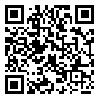Volume 14, Issue 6 (Feb & Mar 2021)
payavard 2021, 14(6): 535-545 |
Back to browse issues page
Download citation:
BibTeX | RIS | EndNote | Medlars | ProCite | Reference Manager | RefWorks
Send citation to:



BibTeX | RIS | EndNote | Medlars | ProCite | Reference Manager | RefWorks
Send citation to:
Zarbi M, Safdari R, Einollahi N. Design, Implementation and Evaluation of Software to Increase Users’ Awareness and Facilitate the Identification of the Most Appropriate Centers Providing Laboratory Services in Tehran Province. payavard 2021; 14 (6) :535-545
URL: http://payavard.tums.ac.ir/article-1-6873-en.html
URL: http://payavard.tums.ac.ir/article-1-6873-en.html
1- Master of Science in Medical Informatics, School of Medical Sciences, Tarbiat Modares University, Tehran, Iran
2- Professor, Department of Health Information Management, School of Allied Medical Sciences, Tehran University of Medical Sciences, Tehran, Iran ,rsafdari@tums.ac.ir
3- Professor, Department of Medical Laboratory Sciences, School of Allied Medical Sciences, Tehran University of Medical Sciences, Tehran, Iran
2- Professor, Department of Health Information Management, School of Allied Medical Sciences, Tehran University of Medical Sciences, Tehran, Iran ,
3- Professor, Department of Medical Laboratory Sciences, School of Allied Medical Sciences, Tehran University of Medical Sciences, Tehran, Iran
Abstract: (2039 Views)
Background and Aim: Medical diagnostic laboratories are among the most important centers in the treatment cycle of patients. Today, the conscious choice of such laboratories is one of the challenges that patients face in the treatment process. This study was conducted with the aim of improving the knowledge of software users in the field of laboratory sciences and also facilitating the conscious and intelligent selection of the laboratory required by users.
Materials and Methods: This is a descriptive-developmental research with an applied approach. The steps consisted of library studies, questionnaire-based needs assessment, collection of knowledge and identity data, design through drawing UML diagrams, implementation using Java programming language, and software evaluation.
Results: A comprehensive system of laboratory information and experiments can be performed in all laboratories in Tehran, based on factors such as location access, types of laboratories and types of tests, a system was designed that allows users to access the most appropriate laboratory centers with high speed and less mobility, sufficient information, and in accordance with their needs. The evaluation was done using a researcher-made questionnaire whose validity and reliability were confirmed. The target population consisted of eleven specialists and forty ordinary users. According to the Likert criterion, the results obtained from the answers of all participants in the study to the questions of the questionnaire were higher than 4.05.
Conclusion: The software showed that the factors that had priority in the need assessment significantly increased user satisfaction and also provided ease of use of laboratory services in accordance with users' needs.
Materials and Methods: This is a descriptive-developmental research with an applied approach. The steps consisted of library studies, questionnaire-based needs assessment, collection of knowledge and identity data, design through drawing UML diagrams, implementation using Java programming language, and software evaluation.
Results: A comprehensive system of laboratory information and experiments can be performed in all laboratories in Tehran, based on factors such as location access, types of laboratories and types of tests, a system was designed that allows users to access the most appropriate laboratory centers with high speed and less mobility, sufficient information, and in accordance with their needs. The evaluation was done using a researcher-made questionnaire whose validity and reliability were confirmed. The target population consisted of eleven specialists and forty ordinary users. According to the Likert criterion, the results obtained from the answers of all participants in the study to the questions of the questionnaire were higher than 4.05.
Conclusion: The software showed that the factors that had priority in the need assessment significantly increased user satisfaction and also provided ease of use of laboratory services in accordance with users' needs.
Send email to the article author
| Rights and permissions | |
 |
This work is licensed under a Creative Commons Attribution-NonCommercial 4.0 International License. |





